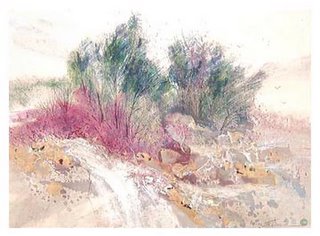
I found an old Camera & Darkroom magazine in my stack of photography magazines. Apparently the magazine is no longer published as I could not Google it up. The publisher was L.F.P. Inc., which, according to my search, published Hustler, so maybe that explains why it is no longer in print. Interesting photography “bedfellows”!
Leafing through my copy of C&D I found an article about photograms. It caught my attention because of my fascination with digital collage. The layered effect often achieved in photograms looks much like the layered collages I create in Photoshop. A photogram is basically an abstract photographic image of light and shadow created without a camera. It is actually a negative created by placing opaque and/ or translucent objects on a sheet of photographic paper then exposed to light. It is processed and developed like a traditional photograph. The results are white silhouettes on a black background.
Davis at
http://www.arts.arizona.edu/are476/Davis/files/fotogr.htm wrote, "Photograms have borne a number of names. Henry Talbot made "photogenic drawings" in the 19th century. Christian Schad, a German artist, made "Schadographs" after World War I. He exposed chance arrangements of found objects and waste materials (such as torn tickets, receipts, and rags) on photographic film. U.S. artist Man Ray undertook similar experiments, which he called "Rayographs," that were effected by arranging translucent and opaque materials on photographic paper. Lucia Moholy and Lazlo Moholy-Nagy's cameraless images bore the name that we most often use now with this class of images, "Photograms." They were interested in photography as a medium of light and form, not sentiments or personal feelings that are the concerns of other art forms. Lotte Jacobi called her lyrical abstractions, made in the 1940s and 1950s, "photogenics." *
Davis gives instructions for making a photogram, but I think I’ll avoid all the darkroom, exposure stuff and shoot for a “digital “ photogram.























 When I opened the box of my assemble-it-yourself kitchen cart I was impressed with the compact, organized packing of the contents. My first impulse was to open all the little packages and jump right in and start screwing (up). I usually read instructions only when I’m elbow deep in frustration, but I listened to my intuition this time and read them first. Glad I did, as the simple as the project appeared, there was an exact procedure that had to be followed. I gave into the designer’s plan and marveled, as I worked, at the precision and planning that went into it. I don’t believe I’ve ever seen such attention to detail. My old “anal” Danish boyfriend couldn’t have done it better. The cart is finished and gracing my kitchen so I decided to create a collage in honor of the project.
When I opened the box of my assemble-it-yourself kitchen cart I was impressed with the compact, organized packing of the contents. My first impulse was to open all the little packages and jump right in and start screwing (up). I usually read instructions only when I’m elbow deep in frustration, but I listened to my intuition this time and read them first. Glad I did, as the simple as the project appeared, there was an exact procedure that had to be followed. I gave into the designer’s plan and marveled, as I worked, at the precision and planning that went into it. I don’t believe I’ve ever seen such attention to detail. My old “anal” Danish boyfriend couldn’t have done it better. The cart is finished and gracing my kitchen so I decided to create a collage in honor of the project.


